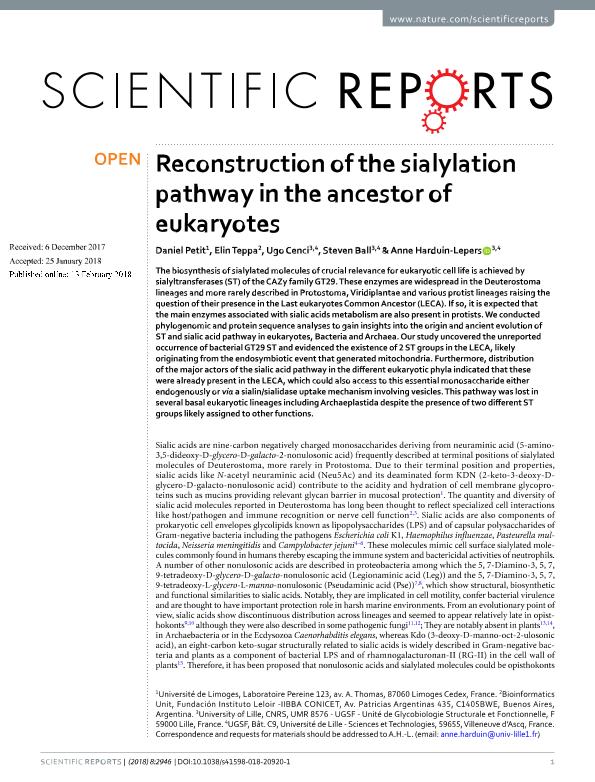Artículo
Reconstruction of the sialylation pathway in the ancestor of eukaryotes
Fecha de publicación:
12/2018
Editorial:
Nature Publishing Group
Revista:
Scientific Reports
ISSN:
2045-2322
Idioma:
Inglés
Tipo de recurso:
Artículo publicado
Clasificación temática:
Resumen
The biosynthesis of sialylated molecules of crucial relevance for eukaryotic cell life is achieved by sialyltransferases (ST) of the CAZy family GT29. These enzymes are widespread in the Deuterostoma lineages and more rarely described in Protostoma, Viridiplantae and various protist lineages raising the question of their presence in the Last eukaryotes Common Ancestor (LECA). If so, it is expected that the main enzymes associated with sialic acids metabolism are also present in protists. We conducted phylogenomic and protein sequence analyses to gain insights into the origin and ancient evolution of ST and sialic acid pathway in eukaryotes, Bacteria and Archaea. Our study uncovered the unreported occurrence of bacterial GT29 ST and evidenced the existence of 2 ST groups in the LECA, likely originating from the endosymbiotic event that generated mitochondria. Furthermore, distribution of the major actors of the sialic acid pathway in the different eukaryotic phyla indicated that these were already present in the LECA, which could also access to this essential monosaccharide either endogenously or via a sialin/sialidase uptake mechanism involving vesicles. This pathway was lost in several basal eukaryotic lineages including Archaeplastida despite the presence of two different ST groups likely assigned to other functions.
Archivos asociados
Licencia
Identificadores
Colecciones
Articulos(IIBBA)
Articulos de INST.DE INVEST.BIOQUIMICAS DE BS.AS(I)
Articulos de INST.DE INVEST.BIOQUIMICAS DE BS.AS(I)
Citación
Petit, Daniel; Teppa, Roxana Elin; Cenci, Ugo; Ball, Steven; Harduin Lepers, Anne; Reconstruction of the sialylation pathway in the ancestor of eukaryotes; Nature Publishing Group; Scientific Reports; 8; 1; 12-2018; 1-13
Compartir
Altmétricas




